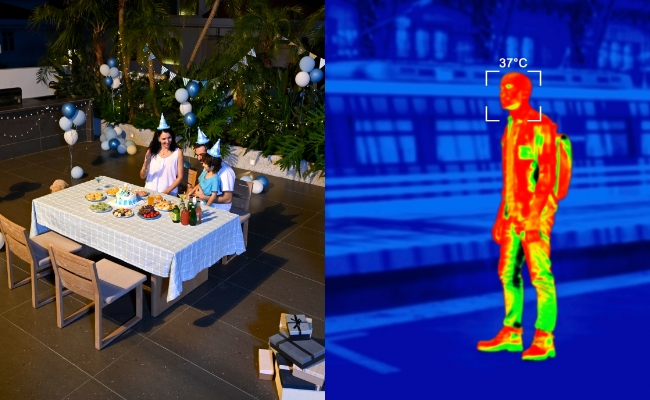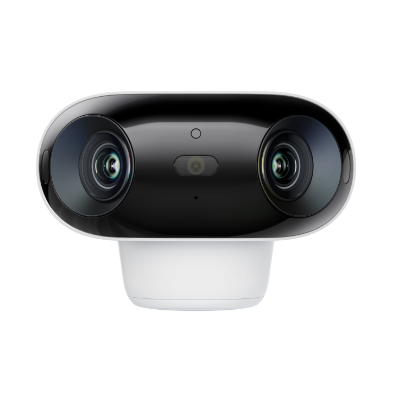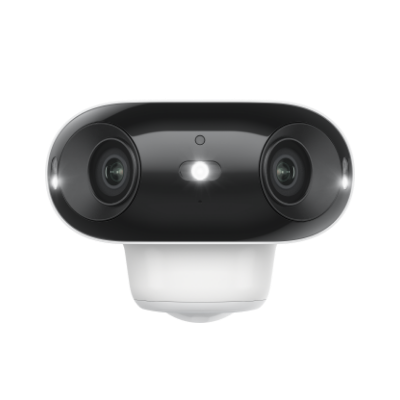Night Vision vs. Thermal: What's the Difference?

Night vision and thermal cameras are distinct imaging technologies and can be used to capture objects in low light or darkness. They work on different principles and are used for different purposes.
In this article, we will explain the difference between these cameras. We will compare them in various aspects and applications to help you choose the right one.
What Is Night Vision?
Night vision cameras generally come with LED spotlights or infrared illuminators. They both have different technology to deal with low light and darkness.
The LED night vision cameras have additional lights to capture the image more clearly. They have a sensor to detect moving objects, and the light suddenly turns on to illuminate the area. Then, the camera can easily capture the person or object with optimal clarity. You get colored footage with this camera.
On the other hand, IR-based night vision cameras emit infrared radiation to eliminate the darkness. It makes the object clear in the darkness by converting the radiation into electrical signals through a sensor. However, the footage is black-and-white. These are highly effective for high security and surveillance at night or low light areas.
What Is Night Thermal?
A night thermal camera works with infrared technology that captures the temperatures of the objects. It usually captures the object with a red gradient, showing a higher temperature above absolute zero.
Thermal imaging will give you a clear overview of the radiations that human eyes can't detect. It makes it easier to detect the objects if they are behind any obstacle by showing their emitted radiation.
Thermal cameras are very efficient for industries to monitor the heat emitted from different machines.
Night Vision Vs Thermal: What's The Difference?
Operating Principle
The night vision cameras work with any available light and amplify it further to create a clear image. The light is magnified, creating a greenish image you are familiar with through movies and cartoons. The IR-based night vision cameras capture black-and-white videos through the radio. And LED cameras illuminate the area and capture colored videos.
Thermal cameras detect the heat emitted by any object above the normal temperature. It converts the detected objects into electrical signals and processes a thermal image. The warmer region will appear red or lighter, while the colder regions will appear yellow or lighter.
Light Dependence
Ambient light is necessary for night vision cameras to function. Mainly, the light sources are starlight, moonlight or any distant source. The night vision cameras will not work in completely dark areas unless you have an LED-mounted one.
Thermal cameras don't need any light source to generate the image. It only shows the heat expelled from the body as a heat map. They are highly effective in smoky, haze, or foggy weather; you can also use them day and night.
Image Output
The IR night vision cameras generate grayscale footage that is clear enough to identify objects. It forms the image with dark or light greenish shades. However, LED light cameras offer colored videos.
In comparison, thermal cameras don't create an image because it shows the heat map showing the temperature differences. The heat map is typically colored with yellow or red combinations, showing the intensity of hot and cold regions.
Cost
Thermal cameras are costly compared to night visions because of their advanced tech and the material required to detect the heat. The night vision cameras are cheaper to make it easier to install in homes while there are some advanced models with higher pricing.
The main reason behind thermal cameras is their capability to capture objects without limitations from obstacles. It has a range of applications and doesn't need any light to generate the results.
Night Vision vs. Thermal: When To Use Them?
Night Vision vs Thermal For Hunting
Night vision cameras are useful in conditions where ambient light is available. Hunters can see clear footage of their prey helping them to take a perfect shot.
In comparison, thermal cameras are more effective because they can detect camouflaged or hidden animals. It can detect wounded animals because of their dripping blood, which is warmer than the surroundings.
Night Vision vs Thermal For Security Surveillance
Night vision cameras are useful for normal household surveillance where there are enough street lights to recognize the person behind the door. The people use IR illuminators to enhance the footage quality.
Night vision is a vital component for 24-hour video surveillance. Users look for cameras that can record clear and detailed images in low light or complete darkness, allowing them to see and recognize essential features. To fulfill these needs, Reolink announces the unique Argus 4 Pro battery security camera, which offers 4K color vision day and night, a 180°blindspot-free view, and a 24-hour battery life with only 10 minutes of charging, among other sophisticated features.
4k 180° Wire-free Color Night Vision Camera
4K UHD 180° Blindspot-free View; Color Vision Day and Night; 30% More Battery Life; Dual-band Wi-Fi 6; Smart detection.
The Reolink Argus 4 Pro is ideal for those seeking full-color night vision without visible spotlights. For a more budget-friendly option with reliable performance, consider the Argus 4 standard version.
4k 180° Blindspot-free Wi-Fi 6 Camera
4K UHD 180° Blindspot-free View; Dual-band Wi-Fi 6; Smart detection; Easy Installation Anywhere
Thermal cameras are effective in surveillance, but you will be unable to recognize the person entering your area. It will only show the heat map of anyone who passes through the area, but they are highly effective in bad weather conditions. You will get the activity of long distances without any light source.
Night Vision Vs Thermal For Obstructed Visibility
Night vision cameras are almost useless in obstructed visibility conditions because they can only capture the footage when ambient light is present. They will not work in rainy or foggy weather conditions.
On the other hand, thermal cameras are highly effective because they can detect the heat rejected from bodies in any condition that a normal camera might block.
Military And Law Enforcement Operations
Night vision cameras are useful in navigating the target area with clear visuals. They help the officials to point the target with accurate positioning. It makes the soldiers plan and conduct the military operations precisely.
In comparison, thermal cameras are invaluable in detecting camouflaged enemies. The soldiers can predict enemies' location even if they hide behind the bushes in darkness. At the same time, a combination of both will be a useful find in critical operations for high accuracy.
Night Vision vs Thermal vs Infrared: What's The Difference?
What Is Infrared?
Infrared is the electromagnetic radiation of higher wavelengths that are invisible to human eyes. They are characterized into three types: near-infrared, mid-infrared, and far-infrared, each having different wavelengths.
Cameras that use infrared radiation to capture footage in low-light conditions are known as infrared cameras. They have infrared LEDs in them.
What's Difference Between Them?
IR night vision cameras use near-infrared technology to make the image visible in low-light areas. It recreates the scenes by amplifying them in a greenish shade.
LED Night vision cameras have built-in LED lights that illuminate the area to capture the true colors of the objects.
The main purpose of infrared radiation is to detect and measure the heat energy from the objects. So, thermal cameras are the perfect example because they use far-infrared rays to detect the emitted heat energy from the objects in the surroundings. Thermal cameras don't need any visible light to generate the heatmap.
FAQs
1. Is night vision infrared?
Yes, they enlighten the fainted image in low lighting or darkness. They use a cathode tube to combine ambient light and near-infrared rays and amplify the signals to generate a clear image.
2. Is thermal or night vision better?
Thermal and night vision cameras have separate working principles and are effective in their domains. You must choose the right one according to the requirements. For instance, night visions are suitable for security surveillance, while thermal ones are exceptional in firefighting inspections.
3. Does the military use night vision or thermal?
Military operations are often conducted with both night vision and thermal cameras because of their unique and distinct advantage. The night vision cameras give them a clear view of the enemy's base in moonlight. In contrast, the thermal cameras effectively spot camouflaged enemies in grass or behind obstacles.
4. Can thermal vision be used as night vision?
Yes, thermal vision can be used as night vision in darkness because of its efficiency in detection, even if there are obstructions. But you must remember that they have certain limits like they can't help you to recognize the person you are looking for.
Conclusion
Night vision and thermal are exceptional technologies that are contributing in various domains. They both have unique and different features that users must understand before buying. We have discussed the important scenarios in the article to make it easier for you to make the right choice.
Search
Be in the Know
Security insights & offers right into your inbox


